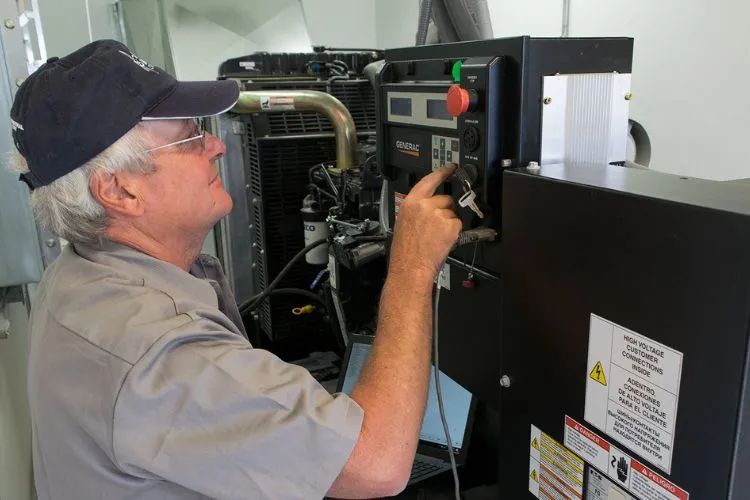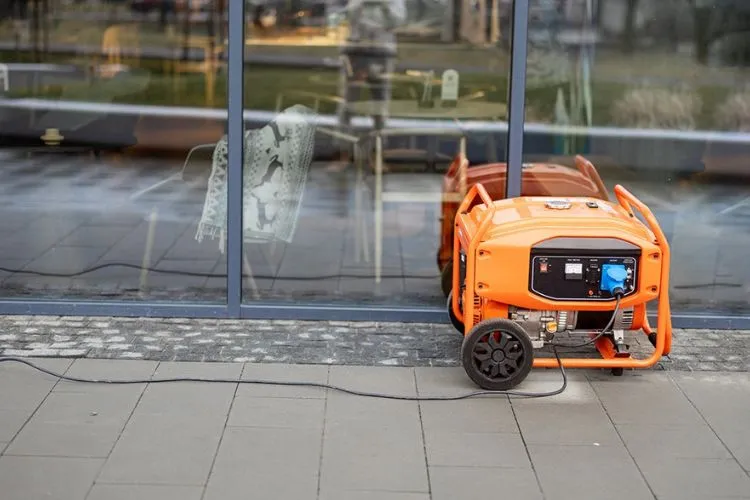Electricity is fundamental to everyday life, powering homes, businesses, and virtually all the technology we depend on. When regular electric sources fail, generators stand ready to supply necessary power.
Have you ever pondered how does a generator create electricity? This article explains the mechanics behind electricity generation through the use of generators and delves into their various components and types.

How Does A Generator Create Electricity?
The scientific foundation of electricity generation in generators is based on electromagnetic induction, a principle discovered by Michael Faraday.
Faraday found that moving a conductor (like a wire) through a magnetic field could induce an electric current.
The process in modern generators is somewhat similar, where mechanical energy is transformed into electrical energy through motion in a magnetic field.
Key Components of a Generator
Understanding a generator’s function starts with its main components:
- Engine: The engine drives the generator by converting the chemical energy in fuel into mechanical energy.
- Alternator: Comprising the rotor (which rotates) and the stator (which remains static), the alternator is critical in converting mechanical energy into electrical energy through electromagnetic induction.
- Cooling and Exhaust Systems: These systems maintain operating temperatures and manage exhaust.
- Fuel System: Stores and provides fuel to the engine.
- Lubrication System: Reduces friction in the engine’s moving parts, ensuring smooth operation.
- Control Panel: Serves as the user interface and controls generator functions.
- Battery Charger: Keeps the starter battery charged.
- Frame: Housing that protects internal components against environmental factors.
Conversion of Mechanical Energy to Electricity
The generator begins its process by the engine burning fuel to generate mechanical motion.
This motion drives the alternator where a magnet turning inside coils of wire induces an electrical current due to the moving magnetic field. The electricity produced then flows out to power external devices and systems.
Different Types of Generators
Generators are available in various designs, tailored for different applications:

Portable Generators
Compact and movable, these units are well-suited for temporary needs like providing electricity during camping trips, outdoor events, or emergency power at homes during brief outages.
Standby Generators
These are permanently installed systems designed to automatically power a home or business when primary electrical supplies fail. They are capable of powering all essential circuits simultaneously.
Specialized Fuel Type Generators
Generators also vary depending on the type of fuel they utilize; common choices include diesel, gasoline, and natural gas, while some newer models might use renewable energies like solar to cater to environmentally conscious consumers.
Generator Safety Tips and Maintenance Best Practices
Ensuring safe operation of generators is critical to avoiding accidents:
Ventilation
Generators emit carbon monoxide, an odorless, colorless gas lethal in high concentrations. Always operate generators outdoors or in well-ventilated areas.
Professional Installation
To ensure compliance with local, state, and federal regulations, including electrical codes, professional installation of permanent units is crucial.
Regular Maintenance
Routine checks and maintenance extend the life of generators and help avoid failures during critical times of need.
The Environmental Impact of Generators
Generators, while indispensable in power emergencies, often run on fossil fuels and contribute to carbon emissions. Traditional diesel and gasoline generators release carbon dioxide, nitrogen oxides, and particulate matter, escalating their environmental impact.
As awareness of climate change rises, the focus has shifted towards more sustainable solutions. Solar-powered generators leverage clean, renewable energy from the sun, mitigating the carbon footprint.
Wind generators capture another free resource, offering a zero-emission alternative where conditions allow. Hybrid generators, combining diesel with battery storage, optimize fuel efficiency and reduce emissions.
Transitioning to such eco-conscious alternatives can greatly diminish the environmental impact of on-demand power generation.
You may also read: Are Diesel Generators Good For Home Use? | What Are The Main Components Of A Generator?
Legal and Safety Regulations for Generator Use
Navigating the legalities and safety standards for using generators is crucial for compliance and protection. Users must check local codes and regulations, as many areas require permits for generator installation, especially for permanent models.
Safety inspections by qualified electricians ensure installations adhere to national standards like the National Electrical Code (NEC).
Furthermore, generators must be located away from buildings to prevent carbon monoxide poisoning, emphasizing the need for proper ventilation.
Noise ordinances also play a role; generators must often operate below certain decibel levels to avoid disturbing neighbors. Non-compliance can lead to fines or legal action, making it essential for users to be informed and conscientious.

Common Issues and Troubleshooting
Generators can encounter issues like failure to start, erratic operation, or power output problems. Common troubleshooting steps include checking fuel levels, ensuring the battery is charged, cleaning air filters, and verifying connections.
If simple fixes don’t resolve the issue, it’s vital to seek professional assistance. Specialists can diagnose complex problems related to the engine or electrical system, ensuring safety and preventing further damage.
Regular maintenance is key to minimizing these issues and prolonging the life of your generator.
Frequently Asked Questions (FAQs)
Can a generator power an entire house?
Larger standby generators are specifically designed to power an entire house. The key is matching the generator’s capacity with the power demands of all necessary appliances and systems.
How long can a generator run continuously?
Operational times vary significantly between models. Portable generators typically offer shorter run times, whereas standby generators can operate as long as their fuel supply lasts. Always consult the manufacturer’s specifications for details.
What distinguishes an inverter generator from a standard generator?
Inverter generators are designed to vary their engine speed based on the electrical demand, which conserves fuel and reduces noise. They typically provide cleaner power which is crucial for protecting sensitive electronic devices.
How do I determine the right size generator for my needs?
Calculate the total wattage of devices you plan to power during an outage and add a margin to accommodate starting currents for appliances like refrigerators and pumps.
Is it safe to use generators in wet conditions?
Operating conventional generators in wet conditions is risky due to potential electrical hazards, including short circuits and electrocution. Special enclosures or canopies can provide the necessary protection from moisture.
Conclusion:
Generators are a robust solution for ensuring continuity of electrical supply in diverse circumstances. By understanding how these devices function, their types, and how to operate them safely, users can effectively meet their power needs reliably and safely.
When choosing a generator, consider your specific requirements, and adhere strictly to safety guidelines to protect yourself and others from potential hazards.
Whether for practical usage or emergency preparedness, a well-chosen generator is a valuable addition to modern living facilities.
